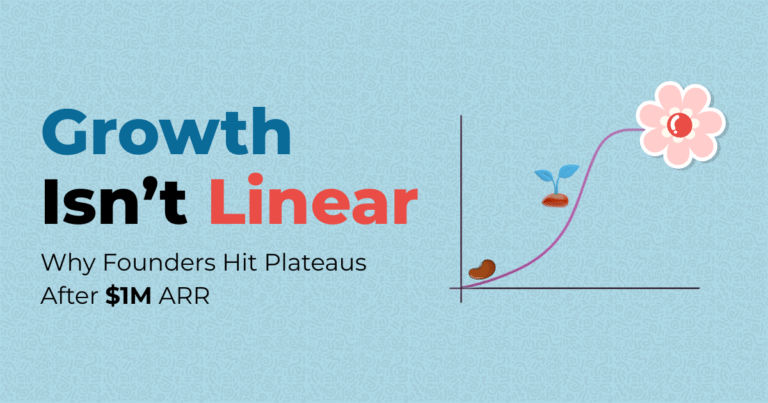Why finding PMF isn’t the finish line, it’s the starting gun.
Key Takeaways
- PMF means your product works. GTMF means your business grows.
- Most of the startups fail after PMF because they never find GTMF.
- GTMF connects product, messaging, channels, and sales into one rhythm.
- Without GTMF, growth can be chaotic, expensive, and unpredictable.
- GTMF defines how value travels from your product to your buyer, repeatedly.
The Myth of “Making It” after PMF
Founders dreams of reaching Product-Market Fit-that magical point when your product clicks, users love it, and retention stabilizes. But here’s the thing: PMF doesn’t equal growth.
In fact, most of the companies that fail after PMF don’t collapse because of the product. They collapse because they never achieve Go-To-Market Fit (GTMF), the ability to repeatedly and predictably sell what they built.
Andreessen Horowitz’s Growth Study 2024 reported that nearly 60% of post-Series A startups with PMF still fail to scale, citing “inefficient GTM models” and “broken sales motion” as top reasons.
PMF tells you there’s demand. GTMF tells you that you can reach it, convert it, and sustain it.
The Core Difference: PMF vs GTMF
| Aspect | Product-Market Fit (PMF) | Go-To-Market Fit (GTMF) |
|---|---|---|
| Goal | Validate that your product solves a real problem | Validate that your business can repeatedly sell and deliver it |
| Focus | Product features, usability, retention | Messaging, channels, pricing, sales process |
| Signal | Users love the product | Customers pay, renew, and refer consistently |
| Primary Metric | Retention, engagement, NPS | Pipeline velocity, CAC/LTV ratio, sales efficiency |
| Champion | Product team | GTM (Marketing, Sales, RevOps) |
| Time Horizon | Early traction | Early scale |
PMF answers: “Does it work?”
GTMF answers: “Can we grow it predictably?”
Why GTMF Is More Important Than PMF
When you achieve PMF, you’ve validated value in theory. When you achieve GTMF, you’ve validated value in motion. The shift from PMF to GTMF is the shift from “build” to “scale.”
Here’s why GTMF matters more for long-term survival:
- PMF is emotional, while GTMF is financial.
PMF makes you feel good because users love you. GTMF proves your business works because customers buy repeatedly. - PMF is about product intuition; GTMF is about process integration.
GTMF forces alignment between product, marketing, and sales. - PMF fades without GTMF.
Even the most loved products die when the GTM system fails; think Clubhouse or Evernote. - Investors fund GTMF, not PMF.
Modern VCs now ask: “Can you sell it repeatedly?” before “Do people like it?”
PMF may make headlines. GTMF makes companies last.
How Founders Can Assess GTMF
Finding GTMF requires structured observation, not gut feeling.
Here’s how founders can diagnose whether they’ve found it:
1. Repeatable Pipeline
You’re not guessing where leads come from. Inbound, outbound, and referral systems generate consistent monthly opportunities.
2. Predictable Conversion
Your length of sales cycles, deal size, and close rate are stable and improving.
3. Sustainable Unit Economics
Your LTV/CAC ratio is > 3, and CAC payback happens in < 12 months.
4. Channel clarity
You’ve identified which acquisition channels compound, and which drain resources.
5. Scalable Delivery
Your post-sale processes can handle growth without breaking customer experience.
If 3 or more of these are true, you’re close to GTMF. If not, you’re scaling noise, not growth.
GTMF by Stage of Business
Go-to-market fit evolves along with your company’s growth. Each stage requires a different balance of clarity, process, and scale.
| Stage | ARR Range | Primary GTMF Goal | Key Focus Areas | Common Mistakes |
|---|---|---|---|---|
| 0–1M ARR (Early) | Finding first repeatable customers | Validate channels, refine ICP, and test messaging | Experimentation, founder-led selling, rapid feedback loops | Over-reliance on referrals or one channel |
| 1–10M ARR (Mid-Stage) | Building predictable pipeline and sales rhythm | Operationalize GTM systems and compounding loops | Marketing-sales alignment, performance tracking, automation | Scaling campaigns before alignment |
| 10M+ ARR (Growth) | Scaling GTM systems globally | Expand channels, localize messaging, optimize conversion | Regional strategy, channel efficiency, data-driven RevOps | Assuming what worked before will still work now |
Early Stage (0–1M ARR)
You’re still testing who your ideal customers are. At this point, GTMF is focused on learning fast, not scaling fast. The goal is to find the repeatable combination of message + channel + offer that converts.
Mid Stage (1–10M ARR)
Now, GTMF moves from validation to optimization. You’re building out infrastructure – automation, analytics, and alignment – to turn repeatable sales into predictable growth.
Growth Stage (10M+ ARR)
At scale, GTMF is about consistency and adaptability. Your focus should be on regionalization, efficiency, and making sure each team motion still aligns with your original narrative and metrics.
GTMF doesn’t end – it evolves.
GTMF in Horizontal vs Vertical Products
| Product Type | Challenges | GTMF Focus |
|---|---|---|
| Horizontal (Broad Use Case) | Harder to message and target; diverse audience | Sharpen ICP and segment by use case to create focused narratives |
| Vertical (Industry-Specific) | Narrow TAM, but high conversion rates | Scale depth before width, focus on domain expertise and community credibility |
Horizontal SaaS: You don’t need everyone. You need a repeatable subset of buyers who share pain, context, and triggers.
Vertical SaaS: You need market depth, not width-a reputation strong enough to dominate your niche before expanding.
Both paths lead to GTMF, but each demands strategic focus over marketing hustle.
How to Build Toward GTMF
- Revisit your ICP.
Define your best-fit customer profile based on sales data, not assumptions. - Align product and sales narratives.
Make sure your product’s “why” matches why your sales team sells it. - Build marketing systems that compound.
Don’t chase impressions; build a flywheel that aligns brand, content, and pipeline. - Operationalize feedback loops.
Marketing insights should inform sales; sales insights should inform product. - Measure GTMF signals on a monthly basis.
Track pipeline velocity, retention, LTV/CAC, and referral rate as GTMF indicators.
GTMF is not a milestone; it’s a motion that matures with every stage.
The Founder’s Reflection
The victory lap for the Founders often is PMF. This is where the real race begins. PMF tells you what works. GTMF tells you how to keep it working, profitably, and at scale. Without GTMF, you’re building growth that does not multiply.
And growth that doesn’t multiply, eventually disappears.
Frequently Asked Questions (FAQs)
1. What is Go-To-Market Fit (GTMF)?
GTMF means your startup has found a predictable, repeatable way to sell and deliver its product profitably.
2. How is GTMF different from PMF?
PMF proves that the product works for the users. GTMF proves that the business model works for the market.
3. How does GTMF change as the company grows?
Early-stage GTMF is about validation. Mid-stage is about process. Late-stage is about optimization and regional scaling.
4. What are the key indicators of GTMF?
Predictable sales conversion and sustainable unit economics from a consistent pipeline generation.
5. Can you lose GTMF?
Yes. With evolving markets, your GTM also needs to change-channels, messaging, and pricing must be recalibrated.




